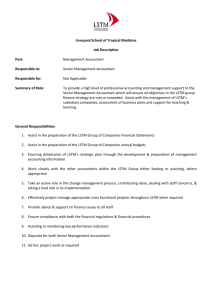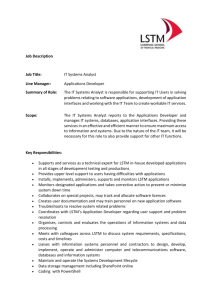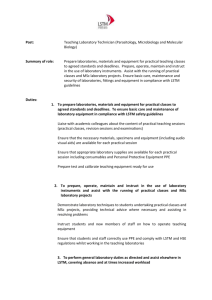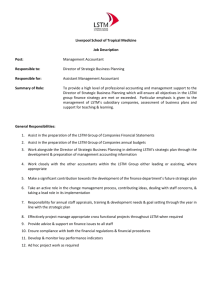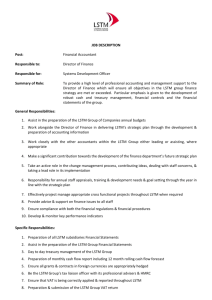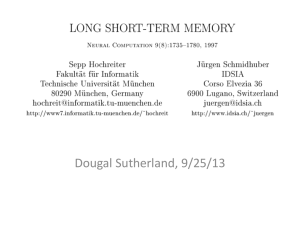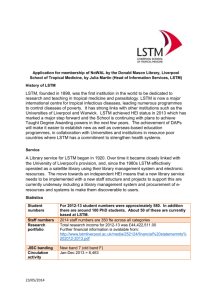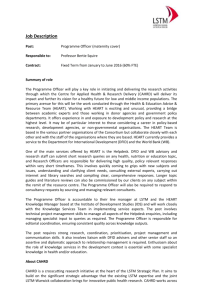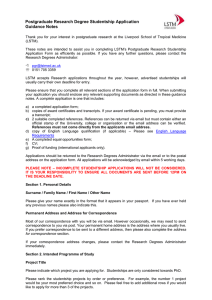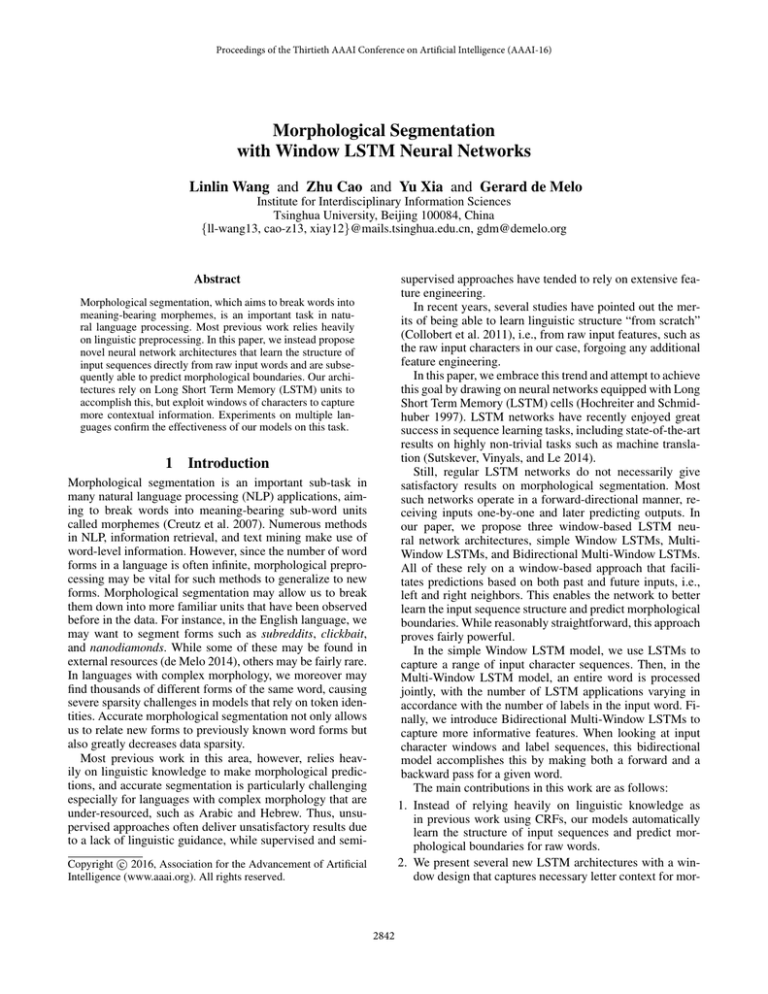
Proceedings of the Thirtieth AAAI Conference on Artificial Intelligence (AAAI-16)
Morphological Segmentation
with Window LSTM Neural Networks
Linlin Wang and Zhu Cao and Yu Xia and Gerard de Melo
Institute for Interdisciplinary Information Sciences
Tsinghua University, Beijing 100084, China
{ll-wang13, cao-z13, xiay12}@mails.tsinghua.edu.cn, gdm@demelo.org
supervised approaches have tended to rely on extensive feature engineering.
In recent years, several studies have pointed out the merits of being able to learn linguistic structure “from scratch”
(Collobert et al. 2011), i.e., from raw input features, such as
the raw input characters in our case, forgoing any additional
feature engineering.
In this paper, we embrace this trend and attempt to achieve
this goal by drawing on neural networks equipped with Long
Short Term Memory (LSTM) cells (Hochreiter and Schmidhuber 1997). LSTM networks have recently enjoyed great
success in sequence learning tasks, including state-of-the-art
results on highly non-trivial tasks such as machine translation (Sutskever, Vinyals, and Le 2014).
Still, regular LSTM networks do not necessarily give
satisfactory results on morphological segmentation. Most
such networks operate in a forward-directional manner, receiving inputs one-by-one and later predicting outputs. In
our paper, we propose three window-based LSTM neural network architectures, simple Window LSTMs, MultiWindow LSTMs, and Bidirectional Multi-Window LSTMs.
All of these rely on a window-based approach that facilitates predictions based on both past and future inputs, i.e.,
left and right neighbors. This enables the network to better
learn the input sequence structure and predict morphological
boundaries. While reasonably straightforward, this approach
proves fairly powerful.
In the simple Window LSTM model, we use LSTMs to
capture a range of input character sequences. Then, in the
Multi-Window LSTM model, an entire word is processed
jointly, with the number of LSTM applications varying in
accordance with the number of labels in the input word. Finally, we introduce Bidirectional Multi-Window LSTMs to
capture more informative features. When looking at input
character windows and label sequences, this bidirectional
model accomplishes this by making both a forward and a
backward pass for a given word.
The main contributions in this work are as follows:
1. Instead of relying heavily on linguistic knowledge as
in previous work using CRFs, our models automatically
learn the structure of input sequences and predict morphological boundaries for raw words.
2. We present several new LSTM architectures with a window design that captures necessary letter context for mor-
Abstract
Morphological segmentation, which aims to break words into
meaning-bearing morphemes, is an important task in natural language processing. Most previous work relies heavily
on linguistic preprocessing. In this paper, we instead propose
novel neural network architectures that learn the structure of
input sequences directly from raw input words and are subsequently able to predict morphological boundaries. Our architectures rely on Long Short Term Memory (LSTM) units to
accomplish this, but exploit windows of characters to capture
more contextual information. Experiments on multiple languages confirm the effectiveness of our models on this task.
1
Introduction
Morphological segmentation is an important sub-task in
many natural language processing (NLP) applications, aiming to break words into meaning-bearing sub-word units
called morphemes (Creutz et al. 2007). Numerous methods
in NLP, information retrieval, and text mining make use of
word-level information. However, since the number of word
forms in a language is often infinite, morphological preprocessing may be vital for such methods to generalize to new
forms. Morphological segmentation may allow us to break
them down into more familiar units that have been observed
before in the data. For instance, in the English language, we
may want to segment forms such as subreddits, clickbait,
and nanodiamonds. While some of these may be found in
external resources (de Melo 2014), others may be fairly rare.
In languages with complex morphology, we moreover may
find thousands of different forms of the same word, causing
severe sparsity challenges in models that rely on token identities. Accurate morphological segmentation not only allows
us to relate new forms to previously known word forms but
also greatly decreases data sparsity.
Most previous work in this area, however, relies heavily on linguistic knowledge to make morphological predictions, and accurate segmentation is particularly challenging
especially for languages with complex morphology that are
under-resourced, such as Arabic and Hebrew. Thus, unsupervised approaches often deliver unsatisfactory results due
to a lack of linguistic guidance, while supervised and semic 2016, Association for the Advancement of Artificial
Copyright Intelligence (www.aaai.org). All rights reserved.
2842
In recent years, however, Collobert et al. (2011) and
several other studies have proposed eschewing background
knowledge-driven feature engineering in favor of approaches that learn linguistic structure “from scratch”, i.e.,
from the raw input data. Neural network-based approaches
are particularly well-suited for this sort of learning and have
been applied to numerous different tasks (Collobert et al.
2011; Wang et al. 2015). Theoretical analysis by Wang and
Manning (2013) has shed further light on the relationship between CRFs and deep neural networks, confirming the benefits of neural network-based approaches.
In this paper, we follow this promising new direction,
making use of neural networks architectures to achieve such
an independence from feature engineering. Our approach relies on LSTM cells’ capabilities for capturing information in
long term memory. LSTMs are a well-known recurrent neural network architecture, due to their ability to capture longrange associations aggregating increasing amounts of information, while avoiding the issue of vanishing gradients in
training (Hochreiter and Schmidhuber 1997). LSTM-based
architectures have achieved state-of-the-art results on tasks
such as English-to-French machine translation (Sutskever,
Vinyals, and Le 2014), syntactic constituency parsing (Tai,
Socher, and Manning 2015), transition-based dependency
parsing (Dyer et al. 2015), and grapheme-to-phoneme conversion (Rao et al. 2015).
Although LSTMs have proven successful in a range of
different settings, they do not yield state-of-the-art results
on morphological segmentation. In this paper, we propose
modified network architectures that aim to better capture
contextual information by going beyond the simple forwardpass architecture used in regular LSTM networks. Instead,
we obtain hybrid models that add aspects of feedforward
networks, similar to how architectures for automatic image captioning combine convolutional neural networks for
image analysis with recurrent networks for sentence generation (Karpathy and Fei-Fei 2015; Vinyals et al. 2014).
Although our new models are guided by the task of morphological segmentation, we note that these do not rely on
segmentation-specific engineering. Instead, their architecture is fairly generic and likely to benefit other sequence
labeling tasks.
phology prediction. While these architectures aim at morphological segmentation, they do not use morphologyspecific engineering and in fact they could also be applied
to other sequence labeling tasks.
3. Even with limited amounts of training data, our LSTM
models achieve good results for languages with complex
morphological forms, opening up the possibility for widespread use for under-resourced languages.
2
Related Work
Research on unsupervised morphological segmentation
started with Harris (1951) half a century ago. For many
years, morphological processing was either performed using
extensive manual rule engineering, which is very costly, or
using finite state automata representing large morphological
dictionaries, which however do not generalize well to new
out-of-dictionary words.
More recent machine learning approaches tend to fall
into three general categories: minimum description length
(MDL) based unsupervised approaches, conditional random field (CRF) based supervised approaches, and semisupervised approaches. MDL-based unsupervised segmentation methods provided for an important breakthrough
and were applied to several languages (Goldsmith 2001).
However, this approach requires manual human retrofitting.
Creutz and Lagus (2002) proposed an unsupervised word
segmentation approach that relies on the MDL principle and
maximum likelihood optimization. One of the most wellknown systems is Morfessor (Creutz et al. 2007), a generative probabilistic model. Poon, Cherry, and Toutanova
(2009) presented an unsupervised method that makes segmentation decisions based on the classic log-linear model
framework, into which contextual and global features like
lexicon priors are incorporated. However, entirely unsupervised systems tend not to be competitive as long as even just
a small amount of segmented training data is available. Furthermore, unsupervised segmentation still has considerable
weaknesses, including oversegmentation of roots and erroneous segmentation of affixes, among others.
To deal with limitations of this sort, approaches such as
minimally supervised Adaptor Grammars have been proposed (Sirts and Goldwater 2013). Ruokolainena et al.
(2013) presented a supervised approach for morphological
segmentation based on conditional random fields, obtaining outstanding results in segmentation with only annotated
data. These supervised approaches only make use of labeled
data. To leverage the unannotated part, a semi-supervised
version of Morfessor was introduced (Kohonen, Virpioja,
and Lagus 2010), as well a method to incorporate unlabeled
data into CRFs by exploiting it in sophisticated ways to augment the feature set with rich features (Ruokolainena et al.
2014).
Still, these supervised and semi-supervised segmentation
approaches require extensive and rather involved linguistic
feature engineering. Apart from this, semi-supervised morphological segmentation also requires rather complex training procedures in conjunction with significant amounts of
labeled and unlabeled data.
3
3.1
Segmentation Models
Morphological Segmentation
Morphological segmentation aims to split words into morphemes. This task can be viewed as a structured classification problem, in which each character is to be assigned one
of several predetermined classes. We denote these classes
as follows: (B) represents the beginning of a multi-character
morpheme, (M) the middle of a multi-character morpheme,
(E) stands for the end of a multi-character morpheme, and
(S) denotes a single character morpheme. Other schemes are
possible as well. For instance, Green and DeNero (2012)
rely on just two class labels (B) and (M), while Ruokolainena et al. (2013) suggests adopting the more fine-grained
set {B, M, E, S}.
2843
4.1
Taking the word “actors” as an example, the corresponding morphological segmentation should be:
act+or+s
By adding the two extra notational symbols <w> and
</w> to indicate the start and end of a word, respectively,
we represent the above segmentation form as:
<w>
a
c
t o r s </w>
START B M E B E S STOP
To summarize, morphological segmentation can be cast
as a sequence labeling problem in which the objective is to
classify each character of a word into one of the aforementioned classes. This typically boils down to maximizing a
log-likelihood function.
Several possibilities for this exist. For instance, one could
formulate the objective as follows with respect to model parameters θ:
log p(l|v; θ)
(1)
θ∗ = arg max
θ
Like regular recurrent neural networks, LSTMs compute a
new hidden state given a previous hidden state and a new
input. However, since ordinary recurrent neural networks,
in training, suffer from the phenomena of exploding and
vanishing gradients, LSTM networks adopt a special form
of memory block to avoid these challenges (Hochreiter and
Schmidhuber 1997).
forget gate f
input gate i
output gate o
Inside the block depicted in Figure 1, there is a memory
cell with a self-recurrent connection and three gates to control its information flow. The input gate i governs the input
flow into the memory cell, and the output gate o determines
to what degree to output new activations. Additionally, the
crucial forget gate f regulates a self-recurrent connection,
enabling this cell to memorize or forget the previous state.
The previous activation h from time t − 1 is fed to the memory at time t through these three gates. The state of the memory cell is fed back together with the forget gate. Formally,
the working principle of the memory block is as follows:
it
ft
ot
ct
ht
(3)
= σ(Wix xt + Wih ht−1 )
= σ(Wf x xt + Wf h ht−1 )
= σ(Wox xt + Woh ht−1 )
= ft ct−1 + it H(Wcx xt + Wch ht−1 )
= ot c t
(4)
(5)
(6)
(7)
(8)
Here, it , ft , ot and ct are activation vectors at time t of the
input gate, forget gate, output gate and memory cell, respectively, the size of which should be the same as for the hidden
vector h. W stands for the corresponding weight parameters,
and its subscripts indicate different connections. denotes
the element-wise product operation with a gate value, σ(·)
is the logistic sigmoid function, and H(·) represents the hyperbolic tangent.
t=0
In the following, we will present LSTM-based neural network architectures capable of modeling either p(L|V ; θ) or
p(Lt |V, l0 , . . . , lt−1 ).
4
Label
Prediction
Figure 1: LSTM Memory Cell Structure
(V,L)
log p(lt |V ; θ; l0 , . . . , lt−1 )
Softmax
(v,l)
Here, V is the input word, L stands for the corresponding
label sequences for this word, (V, L) is a training pair and
θ represents model parameters. Given an input word, composed of several characters, the objective is to maximize the
probability of predicting appropriate label sequences for this
word with current model parameters.
Suppose we have a label sequence L = (l0 , . . . , lT ) for
a word of length T , where each lt represents one particular
label for the t-th time step, i.e., character, of the word. With
the chain rule, we obtain:
T
Memory Cell
Input
Here, v corresponds to a character from a training word, l
is the corresponding label for this character, (v, l) is a training pair and θ represents model parameters. Thus, given
an input character from a word, with Eq. (1), we seek the
best corresponding labels in terms of maximizing the conditional probability. The overall morphological segmentation
task aims at maximizing the log-likelihood over all words in
the training data.
Alternatively, we may also adopt the following form of
log-likelihood function:
log p(L|V ; θ)
θ∗ = arg max
(2)
θ
log p(L|V ; θ) =
LSTM Memory Blocks
Model Architectures
We propose a series of window-based LSTM architectures
for morphological segmentation, with different objective
functions. We begin with a very basic window model, followed by the Multi-Window LSTM model that models entire
words. Finally, we present the Bidirectional Multi-Window
LSTM model that applies both forward and backward passes
to learn more fine-grained sequence features.
4.2
Window LSTM Model
We begin with a simpler model that makes individual predictions for characters. In Eq. (1), we proposed a morphological
segmentation objective that involves maximizing the conditional probability of the predicted label given an input char-
2844
<w> a
the LSTM about the input character contents. Then, Tt is
obtained based on an input, in this case just a starting symbol
S TART. Finally, p is the probability distribution over labels
for the central target character in this input window.
c t o r s </w>
Central Character
Embedding
4.3
LSTM
LSTM
0
0
Figure 2: Window LSTM Model
acter and its associated features with current model parameters. This requires our model to possess the capability of
capturing effective features for the input character and properly describing the conditional probability for the possible
labels. Accordingly, we rely on the architecture illustrated
in Figure 2. An LSTM unit is responsible for automatically
learning the structure of the input window. Given a starting
label (motivated by our desire to later extend this model to
sequences of labels), it then yields a probability distribution
for the candidate labels of the target character.
Unlike regular LSTMs, we adopt a fixed-width window
approach to extract features for the target input character.
This window approach rests on the assumption that the label for a character depends quite substantially on its neighboring characters. For a given character in a word, we consider the size of the window around this character as a hyperparameter. Every character in this window is encoded with a
one-hot representation, and then we feed the entire window
to the LSTM in the hope that it will scrutinize the embedding
so as to capture meaningful signals and structures.
Subsequently, a label is predicted given the previous hidden state and an input l0 (=S TART) as input. Since the activation of h at time t − 1 is fed to the LSTM unit’s memory
at time t via three gates and the state of the memory cell
is fed back with the forget gate shown in Eq. (4), we pass
the resulting ht into the Softmax for label prediction, which
yields a probability distribution p over all candidate labels:
pt+1 = S(ht ),
Input Word
<w> a
Window Approach
c t o r s </w>
Window Central Character
Embedding
LSTM
Labels Sequences
LSTM
0
0
LSTM
1
1
……
(9)
where S(·) stands for the Softmax function.
With the above circuitry, our Window LSTM model tackles the morphological segmentation task in accordance with
Eq. (10) as follows:
Tt−1 = LTW (v)
Tt = We l0
p = LST M (Tt )
Multi-Window LSTMs
Similar to probabilistic sequence models, Collobert et al.
(2011) point out that it can be worth modeling strong dependencies in label sequences. The transition from label i to
label j can be modeled explicitly in a transition score matrix, as a set of parameters, to describe such dependencies.
Indeed, it appears that such transitions can be of great significance in morphological segmentation. To better capture the
label transitions and allow our network to acquire more detailed knowledge of the input structure, we devise a second
architecture that applies LSTMs to an entire label sequence.
This architecture is designed for the objective function
given by Eq. (3). We call it the Multi-Window LSTM model.
While the previous simple Window LSTM model considers a new character window and label independently at each
step, the Multi-Window LSTM model presented here processes an entire word jointly. In a first time step, windows
for all characters are fed to a first LSTM, and then in subsequent time steps, LSTM units predict labels given previous
character labels, denoted as L0 , . . . , Lt−1 , and depicted in
Figure 3.
LSTM
……
T-1
T-1
Figure 3: Multi-Window LSTM model
First, an LSTM encodes the entire input word V , at what
we define to be time step t = −1. We again adopt the window approach proposed earlier to link characters to information about their respective neighboring characters. However,
this time, we connect all the individual windows for the respective characters in a word. We conjecture that this enables
the network architecture to better capture structural features
within the input word automatically.
The LSTMs are then deployed to predict all the labels for
the word. Unrolled, these can be thought of as a series of
(10)
(11)
(12)
where LTW (·) is the embedding form for a character v in
the input window after a lookup table operation, l0 is the
input label, and We is the label embedding matrix. Tt−1 is
obtained based on v by the first LSTM, which aims to inform
2845
Input Word
<w> c a
t </w>
Window
Window
i-1
Forward Layer
0
i-1
N-1
LSTM
LSTM
…
LSTM
LSTM
LSTM
…
LSTM
LSTM
N-1
LSTM
Backward Layer
Figure 4: Bidirectional Multi-Window LSTM model
5
5.1
LSTMs that share model parameters and each focus on one
label lt for a time step t ∈ {0, . . . , T − 1}. LSTMs have
a feed-forward information flow, and ht−1 of the LSTM at
time t − 1 is sent to the LSTM for time t. In terms of Eq. (4),
the predicted label at time t − 1 is fed back in addition to the
memory output at time t into a Softmax operation for label
prediction. Thus, at each time step (after step −1), the probabilities for one label are determined given previous labels.
Overall, we compute:
T−1 =LTW (V )
Tt =We lt for t ∈ {0, . . . , T − 1}
pt+1 =LST M (Tt ) for t ∈ {0, . . . , T − 1}
Experimental Evaluation
Data and Evaluation
S&B data. This well-known data set by Snyder and Barzilay (2008) was derived from biblical text and consists of
Hebrew, Arabic, Aramaic, and English terms together with
their frequencies. Following Snyder and Barzilay (2008) and
other studies, we focus on the morphologically segmented
Hebrew and Arabic words, of which there are 6,192 each.
We follow the commonly used method to partition the
data into training, development (tuning), and test splits
(Ruokolainena et al. 2013). This involves sorting the inputs
according to their frequency and assigning every fifth term
starting from the first one into the test set and every fifth term
from the second into the development set, while leaving the
remaining data as training data. Finally, we randomly select
the first 25%, 50%, 75% and 100% amount of data from the
training set to carry out experiments with different training
sizes.
(13)
(14)
(15)
where LTW (V ) is the encoding form for input word V after
a lookup table operation, and the entire input word here is
composed of windows for every character. lt represents labels from the label sequences for this input word, and We
is the embedding matrix for the label information. l0 and ln
are added to indicate label start and label end, respectively.
T−1 is obtained based on the windows for the input word V
at time −1 and Tt , t ∈ {0, . . . , T − 1}, is obtained based on
every item in the label sequence at time t. Finally, pt+1 is
the resulting probability distribution over labels at time step
t + 1.
4.4
Training
For training, we turn to the log-likelihood functions introduced in Section 3.1. Consider the Multi-Window LSTM
model as an example. Since our training goal in this architecture is to optimize the sum of the log probabilities in Eq.
(2), we define a loss function corresponding to the sum of
negative log-likelihoods of the correct label at each step.
We apply standard stochastic gradient descent with minibatches of training instances, and utilize dropout regularization, while clipping gradients element-wise. We rely on
Beam Search (Cho et al. 2014) to perform inference on the
sequence, i.e., we explore the search space by maintaining
a list of the k most promising options when optimizing for
Eq. (2). In particular, Beam Search repeatedly operates on a
set of top-k most promising sequence predictions, iteratively
considering the k-best list at time t as candidates to generate
potential candidate sequences at time t + 1.
Embedding
0
Embedding
4.5
Inversed Input
Metric We evaluate morphological segmentation in terms
of Precision, Recall and micro-averaged F-metric. The precision gives us the percentage of correctly assigned morpheme boundaries among all assigned boundaries, while the
recall is defined as the percentage of correctly assigned morpheme boundaries among the reference boundaries. The Fmetric is the geometric mean of precision and recall. For the
F-metric, we employ token-based micro-averages (Ruokolainena et al. 2013).
Bidirectional Multi-Window LSTMs
5.2
To improve the accuracy of the morphological segmentation
and exploit LSTM’s advantage in capturing long term memory, we introduce a final architecture, extending the previous
one even further. The Bidirectional Multi-Window LSTMs
we propose in this section are illustrated in Figure 4.
In this architecture, the model first makes a forward pass
to process the sequence in the normal order, and then adopts
an additional backward pass to process it in reverse order.
With these bidirectional passes, the network is able to learn
even more fine-grained features from the input words and
corresponding label sequences.
Results and Analysis
We set the experimental parameters such as window size,
learning rate, dropout rate, evaluation batch size, validation
perplexity, threshold, etc. for the models using the development data. For instance, for 100% Hebrew training, we
set 0.25 as the dropout to apply right after the encoder to
an LSTM in the Window LSTM architecture. We set the
encoder dropout as 0.3 and learning rate to be 0.0005 for
Multi-Window LSTMs (MW-LSTM) architecture. And we
set the encoder dropout as 0.2, learning rate as 0.00065, gradient clipping threshold at 10, decay rate as 0.5, and mo-
2846
Hebrew
25%
50%
75%
100%
Method
S-Morf.
Poon
CRF
LSTM
MW-LSTM
BMW-LSTM
S-Morf.
Poon
CRF
LSTM
MW-LSTM
BMW-LSTM
S-Morf.
Poon
CRF
LSTM
MW-LSTM
BMW-LSTM
E. BMW-LSTM
S-Morf.
Poon
CRF
LSTM
W-LSTM
MW-LSTM
BMW-LSTM
E. BMW-LSTM
Precision
71.5
78.7
90.5
58.2
91.7
95.8
82.1
82.8
94.0
52.5
92.9
92.9
84.0
83.1
94.0
53.9
91.1
92.4
93.1
85.3
83.0
94.9
60.3
91.0
93.2
92.7
95.2
Recall
85.3
73.5
90.6
69.9
85.0
90.7
81.8
74.6
91.5
76.2
88.8
88.8
88.1
77.3
92.7
73.3
92.4
90.4
93.2
91.1
78.9
94.0
65.7
92.8
90.1
91.8
95.2
F1
77.8
75.9
90.6
63.5
88.2
93.2
81.9
78.4
92.7
62.2
90.8
90.8
86.0
80.1
93.4
62.2
91.8
91.4
93.1
88.1
80.9
94.5
62.9
91.9
92.0
92.2
95.2
Arabic
25%
50%
75%
100%
Method
S-Morf.
Poon
CRF
LSTM
MW-LSTM
BMW-LSTM
S-Morf.
Poon
CRF
LSTM
MW-LSTM
BMW-LSTM
E. MW-LSTM
S-Morf.
Poon
CRF
LSTM
MW-LSTM
BMW-LSTM
E. MW-LSTM
S-Morf.
Poon
CRF
LSTM
W-LSTM
MW-LSTM
BMW-LSTM
Precision
78.7
84.9
95.5
74.6
93.3
93.8
87.5
88.2
96.5
72.8
95.0
95.0
95.9
92.8
89.6
97.2
75.4
95.6
96.9
96.5
91.4
91.7
98.1
83.5
95.6
97.1
96.0
Recall
79.7
85.5
93.1
68.7
90.7
90.1
91.5
86.2
94.6
69.9
92.9
92.6
96.1
83.0
86.4
96.1
68.3
94.1
93.2
96.4
91.8
88.5
97.5
65.2
91.6
96.1
95.0
F1
79.2
85.2
94.3
71.5
92.0
91.9
89.4
87.5
95.5
71.3
94.0
93.8
96.0
87.6
87.9
96.6
71.7
94.9
95.0
96.5
91.6
90.0
97.8
73.3
93.6
96.6
95.5
Table 1: Results for Hebrew
Table 2: Results for Arabic
mentum as 0.01 for Bidirectional Multi-Window LSTMs
(BMW-LSTM). Window sizes were chosen from {3,5,7}.
We compare our models with regular LSTMs, which consider characters instead of our windows as inputs. We also
compare our models with supervised approaches that rely on
human-designed features, including that of Ruokolainena et
al. (2013), denoted CRFs for short, and of Poon, Cherry, and
Toutanova (2009), denoted as Poon, as well as with the semisupervised Morfessor variant (Kohonen, Virpioja, and Lagus 2010), denoted as S-Morf. Apart from this, “E.” denotes
that we use ensembles of 10 models, following Sutskever,
Vinyals, and Le (2014).
From Tables 1 and 2, we see that character-based LSTMs
do not yield satisfactory results, while our Window LSTM
models perform significantly better at predicting morphological boundaries on the S&B data. This shows that the
larger contexts that are models capture indeed are helpful.
Thus, new hybrid models that operate on larger windows are
a promising direction worth exploring further.
Our models are also able to outperform feature-rich models in some settings, but not universally. For instance, for
Hebrew with 25% training size, the Bidirectional MultiWindow LSTM model outperforms the CRF method with
relative improvements of 5.86%, 0.11%, and 2.87% for precision, recall, and F1, respectively. For Arabic, we outperform Poon, Cherry, and Toutanova (2009) and S-Morfessor,
but our approach of learning from raw input characters
mostly does not reach the level of scores obtained with
the advanced feature engineering in the CRF models. Our
window-based LSTM approach aims to automatically learn
morphological structure from raw input characters instead
of relying heavily on linguistic knowledge and manual feature engineering. Depending on the complexity of the morphology of a language, adding additional features as ingredients may still be necessary to obtain state-of-the-art results.
Another promising direction is to perform inference in our
models using more sophisticated decoding strategies than a
simple beam search.
In terms of the training data sizes, we see that our model
can perform well even on smaller percentages of the training
data. This is quite remarkable given that they do not benefit from human-engineered features and thus need to induce
good representations from the data. Still, there are some
lower bounds on the number of training examples required
for this to succeed. While the test sets from the Morpho
Challenges 1 are not publicly available, we ran experiments
by partitioning available data into smaller training, development, and test sets for English, Finnish, and Turkish. With
just 500-1000 training examples, our models sometimes succeeded in outperforming CRFs on all three languages, but
with so little training data, this varied significantly between
training runs. As expected, learning good features reliably
1
2847
http://research.ics.aalto.fi/events/morphochallenge/
thus still requires more training data than supervised learning from human-engineered features. However, our experiments show that not very much is needed. Even just using
25% of the available training data from the modestly-sized
S&B data sets for Hebrew and Arabic suffices to achieve
F-scores above 90%.
6
Proceedings of the 50th Annual Meeting of the Association
for Computational Linguistics: Long Papers-Volume 1, 146–
155. Association for Computational Linguistics.
Harris, Z. 1951. Methods in structural linguistics. University of Chicago Press.
Hochreiter, S., and Schmidhuber, J. 1997. Long short-term
memory. Neural computation 9(8):1735–1780.
Karpathy, A., and Fei-Fei, L. 2015. Deep visual-semantic
alignments for generating image descriptions. In IEEE
Conference on Computer Vision and Pattern Recognition
(CVPR).
Kohonen, O.; Virpioja, S.; and Lagus, K. 2010. Semisupervised learning of concatenative morphology. In Proceedings of the 11th Meeting of the ACL Special Interest
Group on Computational Morphology and Phonology, 78–
86. Association for Computational Linguistics.
Poon, H.; Cherry, C.; and Toutanova, K. 2009. Unsupervised morphological segmentation with log-linear models.
In Proceedings of NAACL-HLT 2009, 209–217. Association
for Computational Linguistics.
Rao, K.; Peng, F.; Sak, H.; and Beaufays, F. 2015.
Grapheme-to-phoneme conversion using long short-term
memory recurrent neural networks. In Proceedings of
ICASSP.
Ruokolainena, T.; Kohonena, O.; Virpiojaa, S.; and Kurimob, M. 2013. Supervised morphological segmentation
in a low-resource learning setting using conditional random
fields. CoNLL-2013 29.
Ruokolainena, T.; Kohonenb, O.; Virpiojab, S.; and Kurimoa, M. 2014. Painless semi-supervised morphological segmentation using conditional random fields. In Proceedings
of EACL 2014, 84.
Sirts, K., and Goldwater, S.
2013.
Minimallysupervised morphological segmentation using adaptor grammars. Transactions of the Association for Computational
Linguistics 1:255–266.
Snyder, B., and Barzilay, R. 2008. Cross-lingual propagation for morphological analysis. In AAAI, 848–854.
Sutskever, I.; Vinyals, O.; and Le, Q. V. 2014. Sequence
to sequence learning with neural networks. In Advances in
neural information processing systems, 3104–3112.
Tai, K. S.; Socher, R.; and Manning, C. D. 2015. Improved
semantic representations from tree-structured long shortterm memory networks. arXiv preprint arXiv:1503.00075.
Vinyals, O.; Toshev, A.; Bengio, S.; and Erhan, D. 2014.
Show and tell: A neural image caption generator. arXiv
preprint arXiv:1411.4555.
Wang, M., and Manning, C. D. 2013. Effect of non-linear
deep architecture in sequence labeling. In Proceedings of
the 6th International Joint Conference on Natural Language
Processing (IJCNLP).
Wang, L.; Liu, K.; Cao, Z.; Zhao, J.; and de Melo, G. 2015.
Sentiment-aspect extraction based on restricted boltzmann
machines. In Proceedings of ACL 2015, 616–625.
Conclusion
In this paper, we have proposed three types of novel
window-based LSTM neural network architectures to automatically learn sequence structures and predict morphological boundaries in raw words, without additional feature engineering. Our models achieve good results on a number of
languages without relying on linguistic knowledge. Indeed,
our architectures are fairly general and thus we hope to investigate their performance on further kinds of sequence labeling problems.
7
Acknowledgments
This work was supported in part by the National Basic Research Program of China Grants 2011CBA00300,
2011CBA00301, the National Natural Science Foundation
of China Grants 61033001, 61361136003, 61450110088.
References
Cho, K.; van Merriënboer, B.; Bahdanau, D.; and Bengio, Y. 2014. On the properties of neural machine
translation: Encoder-decoder approaches. arXiv preprint
arXiv:1409.1259.
Collobert, R.; Weston, J.; Bottou, L.; Karlen, M.;
Kavukcuoglu, K.; and Kuksa, P. 2011. Natural language
processing (almost) from scratch. The Journal of Machine
Learning Research 12:2493–2537.
Creutz, M., and Lagus, K. 2002. Unsupervised discovery
of morphemes. In Proceedings of the ACL-02 workshop on
Morphological and phonological learning-Volume 6, 21–30.
Association for Computational Linguistics.
Creutz, M.; Hirsimäki, T.; Kurimo, M.; Puurula, A.;
Pylkkönen, J.; Siivola, V.; Varjokallio, M.; Arisoy, E.;
Saraçlar, M.; and Stolcke, A. 2007. Morph-based speech
recognition and modeling of out-of-vocabulary words across
languages. ACM Transactions on Speech and Language Processing (TSLP) 5(1):3.
de Melo, G. 2014. Etymological Wordnet: Tracing the
history of words. In Proceedings of the 9th Language Resources and Evaluation Conference (LREC 2014). Paris,
France: ELRA.
Dyer, C.; Ballesteros, M.; Ling, W.; Matthews, A.; and
Smith, N. A. 2015. Transition-based dependency parsing with stack long short-term memory. arXiv preprint
arXiv:1505.08075.
Goldsmith, J. 2001. Unsupervised learning of the morphology of a natural language. Computational linguistics
27(2):153–198.
Green, S., and DeNero, J. 2012. A class-based agreement
model for generating accurately inflected translations. In
2848

